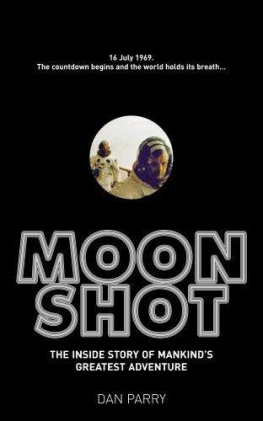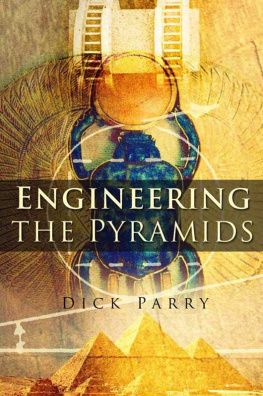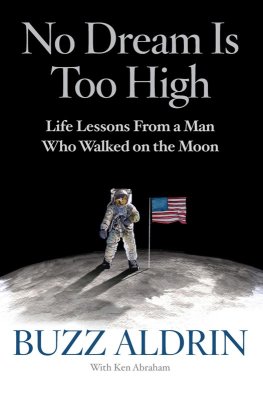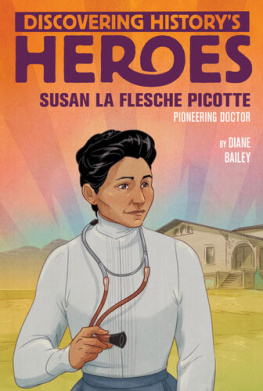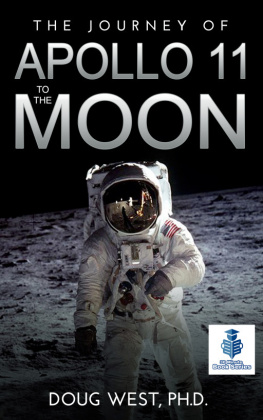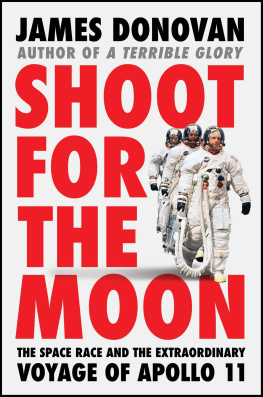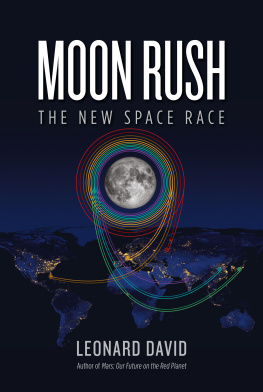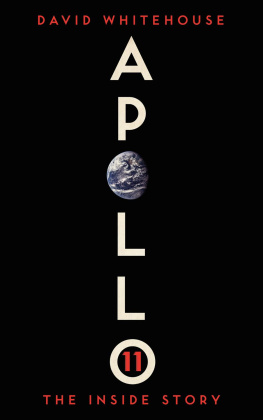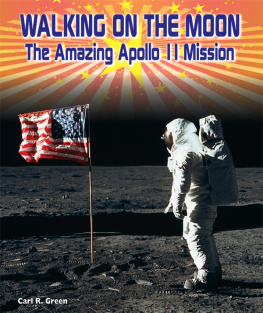Table of Contents
MOON
SHOT
For my Dad, Steve Parry
1943-2008
MOON
SHOT THE INSIDE STORY OF MANKIND'S
GREATEST ADVENTURE DAN PARRY

This eBook is copyright material and must not be copied, reproduced, transferred, distributed, leased, licensed or publicly performed or used in any way except as specifically permitted in writing by the publishers, as allowed under the terms and conditions under which it was purchased or as strictly permitted by applicable copyright law. Any unauthorised distribution or use of this text may be a direct infringement of the author's and publisher's rights and those responsible may be liable in law accordingly.ISBN 9781407027494Version 1.0 www.randomhouse.co.uk
1 3 5 7 9 10 8 6 4 2Published in 2009 by Ebury Press, an imprint of Ebury PublishingA Random House Group CompanyCopyright Dan Parry 2009Dan Parry has asserted his right to be identified
as the author of this Work in accordance with the
Copyright, Designs and Patents Act 1988This electronic book is sold subject to the condition that it shall not by way of trade or otherwise, be lent, resold, hired out, or otherwise circulated without the publisher's prior consent in any form other than that in which it is published and without a similar condition including this condition being imposed on the subsequent purchaserThe Random House Group Limited Reg. No. 954009Addresses for companies within the Random House Group can be found at www.randomhouse.co.uk A CIP catalogue record for this book
is available from the British LibraryISBN: 9781407027494Version 1.0Printed in the UK by CPI Mackays, Chatham, ME5 8TDTo buy books by your favourite authors and register for offers visit www.rbooks.co.uk All photographs featured in this book are courtesy of NASA
Acknowledgements Many people kindly gave this book and the TV show it accompanies much generous support and assistance. The factual drama Moonshot is one of a number of TV shows produced by Dangerous Films focusing on the history of NASA generally and Apollo 11 particularly. Some were completed before the Moonshot project was conceived, but during their production I was enormously privileged to discuss NASA's work with Buzz Aldrin, Neil Armstrong, Gene Cernan, Charlie Duke, Chris Kraft, Gene Kranz, Glynn Lunney, George Mueller and others. Humanity possesses the knowledge and experience to leave our planet at will thanks to the pioneering actions of men such as these, and I remain in awe of their achievements. To those who so patiently helped me with some of the more technical aspects of these achievements, I am grateful. I am particularly indebted to the team behind the exemplary website the Lunar Surface Journal, among them David Harland, Frank O'Brien, David Woods and especially Ken MacTaggart.Staff at the Johnson Space Center, the Marshall Space Flight Center and other NASA sites have been enormously generous in their assistance to all of us at Dangerous, as have experts at the Smithsonian Institution, particularly Dr Roger Launius. Chris Riley's illuminating suggestions were as entertaining as they were valuable, and I am also grateful to the enthusiastic assistance of Doug Millard at the Science Museum. Thanks too to Ken Barlow and Jake Lingwood at Ebury, and especially to Richard Dale and Mike Kemp at Dangerous, whose kind support is greatly appreciated.Above all, I'd like to give heartfelt thanks to my gracious and loving wife Saira, who I'm sure on occasion felt she'd been whisked off to the Moon and stranded in lunar orbit. And to Yasmin, I'd like to say that 'Ubba's boop' is finally finished.
PROLOGUE What would the Moon be like?While this question fascinated those back on Earth, for Neil Armstrong the Moon was playing no more than a supporting role. Here was a chance for man to achieve something beyond comparison. If it were successful, the Apollo 11 mission would demonstrate that humans, as a species, were capable of escaping from their planet and visiting somewhere a world away from home. It didn't matter much whether the Moon was made of brown rocks, grey dust or even green cheese. To Armstrong, all that really counted was landing safely and then coming home again, without letting anyone down in the attempt to do either.Standing in the lunar module, the most fragile manned spacecraft ever built, Armstrong was flying at more than 3,000mph, five times faster than a passenger jet. There were no landing pads on the Moon, no ground crew to guide him down; 50,000 feet below him lay nothing more than an uncharted area that was pockmarked by rocks and craters and which was believed to be a little less dangerous than other uncharted areas. If he were to reach his designated target site, Neil would have to gradually reduce his speed to walking pace and then find a relatively benign area to touch down before his fuel ran out. There was little margin for error. Landing too fast on a landscape strewn with boulders could damage the spacecraft and potentially end any hope of returning home.One way or the other, in the next 12 minutes it would be over and all the hand-wringing, the months of agonising expectation and the endless press questions could finally be laid to rest. The newspapers were fascinated by lunar landscapes. But while rocks and craters captured the media's attention, for a pilot they were to be avoided. As far as Neil was concerned, Apollo 11 wasn't about boxes of stones. Exploring the surface was secondary to the mission's prime objective. None of the early aviation pioneers, who had so inspired Neil as a boy, had regarded their greatest triumph to be a stroll beside their aircraft. Armstrong, like the Wrights, Earhart and Lindbergh before him, knew that nothing was more significant about a test-flight than safely completing it.Standing beside Neil was Buzz Aldrin, and together the two men would have considered themselves to be flying horizontally face down had they not been in weightlessness. They were also travelling backwards, feet first, using the engine as a brake to reduce their speed. The gleaming white surfaces of their cramped cabin were bathed in sunlight, yet somehow the aura of a brandnew spaceship was personalised by the grubby ways of people. Handwritten notes were stuck on the dull grey instrument panels and here and there other personal items were secured by Velcro or held down by netting. Having taught himself to go to the Moon, man was bringing with him urine bags, food trays and doodles in margins.While Buzz monitored the instruments, Neil looked through the triangular window in front of him. In timing their journey over the alien terrain below, he discovered with dismay that the crater known as Maskelyne-W had arrived early. They were three seconds ahead of themselves, and three seconds equated to three miles, which would take them beyond the edge of the landing zone. They would be coming down in an area Neil knew to be strewn with boulders, and in a spacecraft with walls so thin you could poke a pencil through them. He knew they would be lucky to avoid any damage. Luck wasn't enough. He had the facility to override the computer and fly the spacecraft manually but this could only be done in the closing stages of the descent. For the moment he must follow the flight-plan.At 40,000 feet, Armstrong rotated the lunar module by 180 degrees so that he was no longer looking down at the Moon but staring up into space. By repositioning the spacecraft, which was operating under the call-sign Eagle , Neil enabled the landing radar to get a clearer view of the surface. Now that they were due to land long he needed as much reliable information as he could get.Then the yellow master alarm started to flash, a tone sounded in Neil's headset and the computer's yellow PROG light lit up. The computer would help diagnose the problem, allowing Armstrong and Aldrin to decide what action to take based on lessons learned during training. 'It's a 1202,' Neil told Houston after glancing at the computer display. It was a code neither he nor Buzz had ever seen during training, so now they had two problems. The computer could be signalling an immediate need for action, yet incapacitated by uncertainty they could do nothing but wait for advice from home.The seconds slowly ticked by. Neil was prepared to abort at any moment should it suddenly become obvious that they were in serious trouble. As commander of the mission his decision was final, and if the situation demanded it he would take action, whether Houston had replied in time or not. Conscious that the situation could rapidly deteriorate, Armstrong quickly assessed the performance of the spacecraft's systems. He urgently needed to know whether the alarm required them to immediately abort the flight. In the absence of information, 18 seconds after calling for assistance he was forced to repeat his request, and for the first time anxiety could be heard in his voice.'Give us a reading on the 1202 program alarm.'A further five seconds later, Houston finally replied: 'Roger. We're go on that alarm.' Using the jargon of Mission Control, the ground assured Neil that the alarm could be switched off and that it was safe to continue the flight.Mission Control tried to pass on additional information but the haunting sound of static interrupted the transmission, and for a while communication was intermittent. There were many moments when Neil and Buzz simply didn't know how closely the flight controllers were able to follow the data that was automatically sent back from the spacecraft. This was something they had never practised for. Training simulations had either gone well or something had gone wrong; the question of things-kind-of-being- OK-but-it's-hard-to-be-sure had never arisen, and the astronauts found it distracting. The computer alarm was even worse. It continued to signal a warning, and for Neil and Buzz it seemed that they had a genuine problem. Houston was three days away, and confronted by an error in their timing, broken communications and recurring alarms, Armstrong and Aldrin were relying on pure piloting skills. It was hard to be sure about where they were going to come down, but then it didn't really matter as long as they came down safely. Apollo 11 was no longer confined to the science of computers and trajectories, it was about the art of flying.Lying on its back, Eagle gradually pitched upright towards a vertical position, giving Neil a clear view of the ground ahead. The computer was guiding the spacecraft directly towards a huge crater beside a field of boulders, any one of which could smash the lunar module's landing gear or the engine bell. At less than 1,000 feet Neil took partial control of the spacecraft. Using a hand controller, he cut the descent rate and focused on flying forward, skimming over the dangers below without a word to Mission Control. In Houston the flight controllers were all but paralysed by the tension as it became clear that Neil was delaying the landing. Each man knew that the spacecraft was approaching an altitude just a few hundred feet above the surface that was known to be a point of no return, a part of the flight path referred to as the dead-man's box. Attempting an abort at this point was fraught with danger. Neil now had to land, safely and quickly, before his fuel ran out.No TV pictures were being transmitted from the spacecraft so all the flight controllers had to go on was their telemetry. But this didn't explain why Armstrong was taking so long to come down, nor did Buzz's emotionless reading of the instruments.'3 down, 220 feet, 13 forward,' said Buzz, reporting on the lunar module's rate of descent, altitude and velocity.There was no response from Houston.'11 forward. Coming down nicely.'200, 4 down.'5 down.'160, 6 to 6 down.'5 down, 9 forward. That's good.'120 feet.'100 feet, 3 down, 9 forward. Five per cent.'OK. 75 feet. And it's looking good. Down a half, 6 forward.'A curt announcement of '60 seconds' from the ground reminded the crew that soon they must land or attempt to abort. To Armstrong, fuel getting low and time running out were mere parts of an equation. There was no need nor time to discuss them with Buzz. Nor did he say much to Houston, only occasionally pressing the switch that would transmit his words. A man with a cool yet agile mind, Neil's ability to conceal much of it from the world was something the world occasionally found frustrating. It barely mattered to Neil that they were now three miles beyond the ideal landing zone, that communications were patchy and that the fuel was low; what mattered as he searched for a safe spot to land was that there were rocks below. The fuel was a concern, but he believed he had enough to do the job.Supporting Neil with a constant account of their position, Buzz continued to read aloud from the instruments: '4 forward. 4 forward. Drifting to the right a little. OK. Down a half.''30 seconds,' called Mission Control.With their role on this phase of the mission coming to a close, the flight controllers were now no more than spectators, like everybody else. In truth, nothing needed to be said. It was down to Armstrong.


